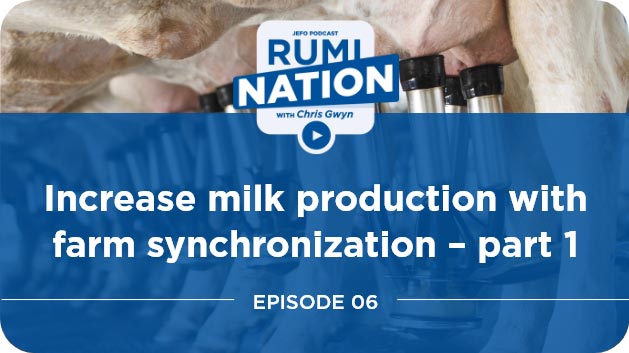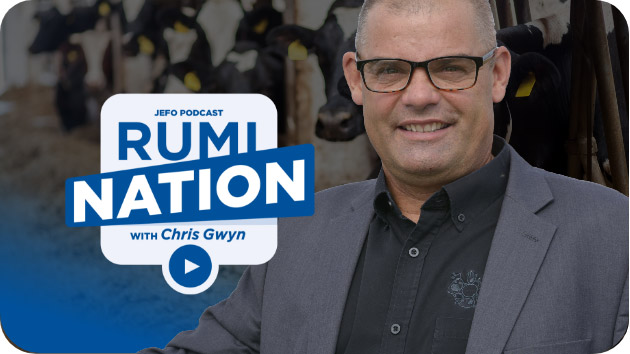RumiNation | S02 : E07
Increase Milk Production with Farm
Synchronization – Part 2
Brought to you by Jefo Nutrition
Share now!
Did you enjoy this episode?
Share now!
Increase Milk Production with Farm Synchronization – Part 2
How could you design or redesign your feed area to get a better farm synchronization? Why does it improve your efficiency, make you save big, and make your employees happier?
Learn everything about the benefits of an organized feed area and farm synchronization with expert consultant David Greene.
Our guest - David Greene
David Greene is an independent dairy production consultant with Barton, Kiefer, and Associates. David is also the owner of Greene Ag Solutions and International Dairy Solutions. He has over 25 years of complete herd nutrition and on-farm management experience.

Timestamps & Summary
01:20:00 – In a previous episode, you expanded on your approach on farm synchronization to improve efficiency. Could you expand specifically on how the feed centre and mixing feed impact the overall farm synchronization?
There is currently a great lost of efficiency when it comes to feed centres. To prevent that, David Greene developed what he calls a « feed-zone model concept » that you apply when you design or redesign a feed centre. It looks at all the traffic movements around the feed centre so you don’t have a lot of interference, and you can make it more efficient for the feeding operation group to get the cows fed.
03:22:00 – Could you expand a bit about the experience you had with clients you helped remodel?
Time is money, and David Greene’s 5-step model for the feed zone has been proven profitable for his clients. It includes having your ingredients closest to the feed centre, and keeping activities such as off-farm deliveries out the feed zone.
05:05:00 – When you get into a large-scale dairy farm, there are feed deliveries happening all the time and considerations about biosecurity and safety need to be taken. How does it also impact organizing the feed centre?
As we mentioned in the episode Increase milk production with farm synchronization, a perfect timing is to feed the cows around 2h ahead of the parlour. If you can make, mix and deliver the feeds from the feed centre to the cow in a timely manner, then it allows you to focus on the cow and to do what’s best for her. That’s the number one goal: focusing on the cow so she’s as productive as she can be.
6:12:00 – Are they big investments needed?
Some of the largest dairy farms David Greene has done needed about a million dollars for their feed centre, but they were able to have a return on their investment in about 15 to 16 months.
6:58:00 – What would be the take-home messages for a dairy producer looking at their dairy farm saying, « Hey, I wonder if I’m losing out efficiency in my feed area, what should I be looking at »?
The biggest thing is: You need to know where you’re at before you start managing it. You need to understand what it costs your farm to make, mix, and deliver feed. David’s consulting team assesses the farms and break down the opportunities into 14 different areas that it can help with.
While you reorganize for efficiency and profit, you also need to take safety into consideration as the feed zone is usually a fast-pace area.
Often times, by reorganizing the feed area, David’s team can reduce the cost of making, mixing, and delivering feed by half. Also, the employees are more content, and therefore there is less labour turnover.






